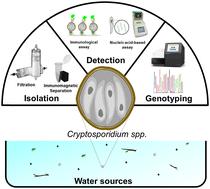当前位置:
X-MOL 学术
›
Environ. Sci.: Water Res. Technol.
›
论文详情
Our official English website, www.x-mol.net, welcomes your feedback! (Note: you will need to create a separate account there.)
Critical evaluation of current isolation, detection, and genotyping methods of Cryptosporidium species and future direction
Environmental Science: Water Research & Technology ( IF 5 ) Pub Date : 2024-04-24 , DOI: 10.1039/d3ew00469d Rabbee G. Mahmudunnabi , Surasak Kasetsirikul , Narshone Soda , Mohamed Sallam , Amandeep Singh Pannu , Nam-Trung Nguyen , Helen Stratton , Muhammad J. A. Shiddiky
Environmental Science: Water Research & Technology ( IF 5 ) Pub Date : 2024-04-24 , DOI: 10.1039/d3ew00469d Rabbee G. Mahmudunnabi , Surasak Kasetsirikul , Narshone Soda , Mohamed Sallam , Amandeep Singh Pannu , Nam-Trung Nguyen , Helen Stratton , Muhammad J. A. Shiddiky

|
Globally, Cryptosporidium continues to pose a significant health and economic burden despite significant efforts to develop effective on-site biosecurity and best management practices. According to the Global Burden of Disease Study (2016), this parasitic protozoan is responsible for more than 48 thousand deaths in children under the age of five and 7.2 million disability-adjusted life-years worldwide. Additionally, most Cryptosporidium species (e.g., Cryptosporidium hominis, Cryptosporidium parvum, etc.) are resistant to the majority of common disinfectants and can survive outside the body for extended periods. Consequently, it is crucial to establish a prompt and accurate diagnosis as well as the severity of the disease to prevent the spread of parasites and to enable effective management strategies. USEPA Method 1623 is currently used in centralized laboratories to perform routine diagnostic tests for this parasite. This process is laborious, expensive, and time-consuming. In the past ten years, a multitude of techniques based on conventional molecular biology techniques, such as polymerase chain reaction (PCR), nested-PCR, loop-mediated isothermal amplification (LAMP), recombinase polymerase amplification (RPA), and nucleic acid sequence-based amplification, have been utilized to analyze Cryptosporidium species. Similarly, several biosensing techniques have been developed in recent years, including electrochemical biosensors and the CRISPR-Cas system in lateral flow assays. This review discusses the most frequently employed techniques for isolating, quantifying, and genotyping Cryptosporidium species, and their implication on the diagnostic landscape. A subsequent evaluation of the most significant technical and biological challenges and limitations of these techniques is also undertaken.
中文翻译:

隐孢子虫当前分离、检测和基因分型方法的批判性评价和未来方向
在全球范围内,尽管为开发有效的现场生物安全和最佳管理实践做出了巨大努力,但隐孢子虫仍然造成重大的健康和经济负担。根据全球疾病负担研究(2016),这种寄生原生动物导致全球超过 4.8 万名 5 岁以下儿童死亡和 720 万残疾调整生命年。此外,大多数隐孢子虫物种(例如,人隐孢子虫、小隐孢子虫等)对大多数常见消毒剂具有抗药性,并且可以在体外长时间存活。因此,及时准确的诊断以及疾病的严重程度对于防止寄生虫传播并制定有效的管理策略至关重要。 USEPA 方法 1623 目前在集中实验室中用于对这种寄生虫进行常规诊断测试。这个过程是费力、昂贵且耗时的。在过去的十年中,基于常规分子生物学技术的多种技术,如聚合酶链式反应(PCR)、巢式PCR、环介导等温扩增(LAMP)、重组酶聚合酶扩增(RPA)和核酸序列基于放大的扩增已用于分析隐孢子虫物种。同样,近年来开发了多种生物传感技术,包括电化学生物传感器和侧流分析中的 CRISPR-Cas 系统。本综述讨论了最常用的隐孢子虫物种分离、定量和基因分型技术及其对诊断领域的影响。随后还对这些技术最重要的技术和生物学挑战和局限性进行了评估。
更新日期:2024-04-24
中文翻译:

隐孢子虫当前分离、检测和基因分型方法的批判性评价和未来方向
在全球范围内,尽管为开发有效的现场生物安全和最佳管理实践做出了巨大努力,但隐孢子虫仍然造成重大的健康和经济负担。根据全球疾病负担研究(2016),这种寄生原生动物导致全球超过 4.8 万名 5 岁以下儿童死亡和 720 万残疾调整生命年。此外,大多数隐孢子虫物种(例如,人隐孢子虫、小隐孢子虫等)对大多数常见消毒剂具有抗药性,并且可以在体外长时间存活。因此,及时准确的诊断以及疾病的严重程度对于防止寄生虫传播并制定有效的管理策略至关重要。 USEPA 方法 1623 目前在集中实验室中用于对这种寄生虫进行常规诊断测试。这个过程是费力、昂贵且耗时的。在过去的十年中,基于常规分子生物学技术的多种技术,如聚合酶链式反应(PCR)、巢式PCR、环介导等温扩增(LAMP)、重组酶聚合酶扩增(RPA)和核酸序列基于放大的扩增已用于分析隐孢子虫物种。同样,近年来开发了多种生物传感技术,包括电化学生物传感器和侧流分析中的 CRISPR-Cas 系统。本综述讨论了最常用的隐孢子虫物种分离、定量和基因分型技术及其对诊断领域的影响。随后还对这些技术最重要的技术和生物学挑战和局限性进行了评估。



























 京公网安备 11010802027423号
京公网安备 11010802027423号